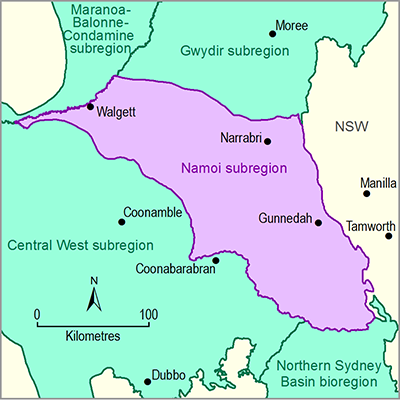While the Namoi subregion has a long history of coal mining, the subregion is experiencing an increase in the intensity of mining and CSG activities with the expansion of existing mines and new coal resource developments commencing or in the pipeline. Many of the hazards expected from mining are expected to be observed locally in the subregion (e.g. subsidence, depressurisation of aquifers and disruption of natural drainage) and their potential effects on water resources and water-dependent assets are recognised. The local experience of coal mining hazards and their effects is supported by international experience, and the risks from many hazards are managed through existing regulatory controls on mine planning and operations management.
The extent to which the development of CSG in the subregion, coupled with an expansion in mining activities, will impact on water-dependent assets is hard to predict. This means that uncertainty exists in the precise spatial extent of groundwater level decline and surface water changes due to coal mines and CSG operations. For example, the uncertainty analysis undertaken for the numerical groundwater modelling does allow a probabilistic estimate of maximum groundwater level decline, as described in companion product 2.6.2 for the Namoi subregion (Janardhanan et al., 2018). Surface water modelling and associated uncertainties are also restricted as a result of the inability to model streams with limited or non-existing gauging information.
The Assessment team considers that faults are unlikely to be a major influence on modelling groundwater flow at the regional scale. The model developed for the BA of the Namoi subregion is regional in scale and does not incorporate faults directly. It uses a statistical approach that is stochastically evaluating a very wide range of uniform parameter values, which accounts for the regional impacts of faults. The high end of the parameter range can be thought of as the hydraulic properties that are equivalent to an aquitard locally compromised by faults. Companion product 2.6.2 for the Namoi subregion (Janardhanan et al., 2018) provides the results of this, and from it we can take that faults are unlikely to have a major impact in the regional groundwater model. Faults do, however, have the potential to have a major influence on groundwater flow at a local scale, and addressing the potential influence of faults at the local scale would require investigation in local scale assessments.
Subterranean faults and fractures also affect the flow paths for methane. In areas where faults and fractures connect the coal seam with surface water, hydraulic fracturing could increase methane leakage to aquifers and connected surface waters. Analyses of petroleum well completion reports (where gas content logs exist) and gas absorption tests of cores may assist in addressing this. Some of this information may be available from the Digital Imaging of Geological System website (NSW Government, 2017).
The lack of information with regards to the interactions of the causal pathways with surface and groundwater quality is a major gap. The lack of long-term, consistent water quality measurements of surface water and groundwater systems limits the value of developing a water quality focused coupled surface water – groundwater model in the Namoi subregion.
The causal pathway groups link hazards to subregion assets but do not predict the impact. Numerical modelling is needed to determine whether the magnitude of change from mining activities and strength of connection to each subregion asset, as mediated by existing regulatory controls, are sufficient to impact each asset. This is a gap being addressed through the quantitative modelling within the BAs.

Product Finalisation date
- 2.3.1 Methods
- 2.3.2 Summary of key system components, processes and interactions
- 2.3.3 Ecosystems
- 2.3.4 Coal resource development pathway
- 2.3.5 Conceptual modelling of causal pathways
- Citation
- Acknowledgements
- Currency of scientific results
- Contributors to the Technical Programme
- About this technical product
